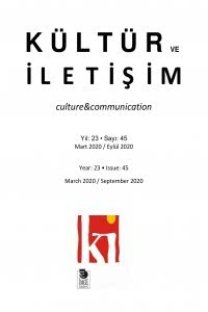Küresel Medya Ürünlerinin Yerelleştirilmesiyle Ulusaşırı Gençlik Kültürlerinin İnşası: Rolling Stone/Türkiye Örneği
Bu yazıda bir küresel kitle kültürü ürünü olarak Rolling Stone (RS) müzik dergisini inceliyorum. İncelemede, ABD ve Türkiye'de yayınlanan RS dergisinin aynı dönem sayılarını karşılaştırdım. Bunun için medya ve kültürel çalışmalar yöntemlerinden yararlandım. Batı ürünü imgeler, semboller, değerler nasıl yerelleştirilmekte ve anlamlar nasıl oluşturulmakta sorularını cevaplamak için metin analizi yöntemini uyguladım. Ayrıca Türkiye editörü Mehmet Tez ile derginin ekonomi politiği, editoryal üretim süreci ve yayın politikası üzerine bir görüşme yaptım. Rolling Stone/Türkiye, Haziran 2006'da üç farklı kapak/aynı içerikle Ciner Medya Grubu çatısı altında yayın hayatına başladı. Dergi günümüzde ABD dışında 16 farklı ülkede yayınlanmaktadır. Ulus aşırı sermayenin bir ürünü olarak bu kadar geniş alana yayılan bir küresel markayı incelemek, hitap ettiği hedef kitlenin ”gençlerin” hayatını, diğer bir deyişle bazı yaşam biçimlerini nasıl dönüştürdüğünü ve homojenliğinin boyutlarını sorgulayabilmeyi tartışmaya açıyor
Anahtar Kelimeler:
Küresel medya, gençlik kültürü, yerelleşme
Construction of Transnational Youth Cultures by Localization of Global Media Products: The Case of Rolling Stone/Turkey
In this paper, I'm analyzing Rolling Stone (RS) music magazine as a product of mass global culture. For this analysis, I compared and contrasted the RS volumes that were published in the USA and Turkey at the same periods. In order to manage this, I benefitted from the methods of media and cultural studies. I applied textual analysis method so as to reflect how West-oriented images, symbols and values are localized and how the meanings are constructed. Furthermore, I made an interview with RS/Turkey editor Mehmet Tez, about economy politics, editorial production stage and publishing policy of the magazine. Rolling Stone/Turkey (RS/Turkey) started to be published in June 2006 with three different cover/same content by Ciner Media Group. Examining a global brand that has spread over such a vast area paves the way for the arguments on questioning the dimensions of its homogeneity and how it transforms lives -in other words- life styles of the target audience“youth.”
Keywords:
Global media, youth culture, localization,
___
- Austin, Erica Weintraub, vd. (2002). “The Effects of Increased Cognitive Involvement on College Students' Interpretations of Magazine Advertisement for Alcohol.” Communication Research 29: 155-179.
- Bell, Philip and Makro Milic (2002). “Goffman's Gender Advertisements Revisited: Combining Content Analyses.” Visual Communication 1(203): 203-222.
- Bottomley, Gill (1993). “Post-multiculturalism? The Theory and Practice of Heterogeneity.” Post-colonial Formations: Nations, Culture, Policy konferans tebliği. Queensland: Griffith University.
- Fornas, Johan and Goran Bolin (1995). Youth Culture in Late Modernity. London and Thousand Oaks: Cal.
- Giddens, Anthony (2000). Elimizden Kaçıp Giden Dünya. Çev., Osman Akınhay. İstanbul: Basım Yayım Dağıtım Ltd. Şti.
- Giddens, Anthony (1989). Sociology. Cambridge: Polity.
- Hall, Stuart (1998). “Yerel ve Küresel: Küreselleşme ve Etniklik.” Kültür, Küreselleşme ve Dünya-Sistemi. Anthony King (der.) içinde. Çev., Gülcan Seçkin ve Ümit H. Yolsal. Ankara: Bilim ve Sanat Yayınları. 39-61.
- Hebdige, Dick (1988). Gençlik ve Altkültürleri. Çev., Esen Tarım. İstanbul: İletişim Yayınları.
- Kellner, Douglas (1995). Media Culture, Cultural Studies, Identity and Politics Between the Modern and the Postmodern. London and New York: Routledge.
- Millar, Brett (2008). “Selective Hearing: Gender Bias In the Music Preferences of Young Adults.” Psychology of Music 36(4): 429-445.
- Miller, Toby, vd. (2005). Global Hollywood 2. London: BFI.
- Muggleton, David (2003). The Post-subcultures Reader. London: Berg
- Schröder, Kırca, Süheyla (2007). Popüler Feminizm: Türkiye'de ve Britanya'da Kadın Dergileri. İstanbul: Bağlam.
- Williams, Raymond (1983). Keywords. London: Fontana.
- ISSN: 1301-7241
- Yayın Aralığı: Yılda 2 Sayı
- Başlangıç: 1998
- Yayıncı: İmge Kitabevi Yayınları
